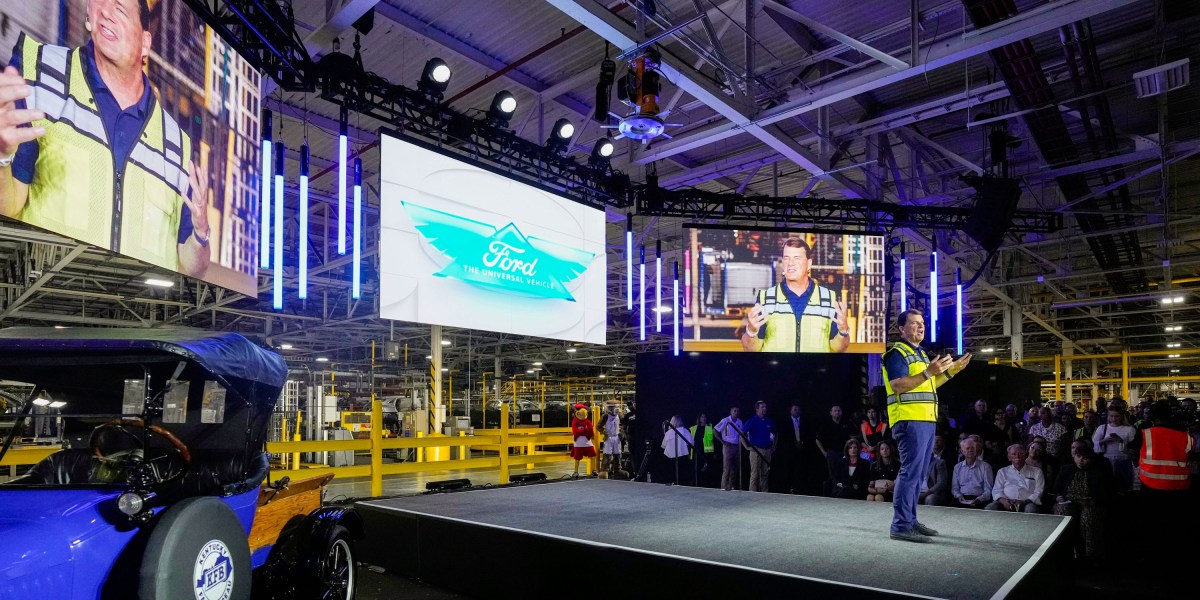This is today’s edition of The Download, our weekday newsletter that provides a daily dose of what’s going on in the world of technology.
The US could really use an affordable electric truck
On Monday, Ford announced plans for an affordable electric truck with a 2027 delivery date and an expected price tag of about $30,000, thanks in part to a new manufacturing process that it says will help cut costs.
This could be the shot in the arm that the slowing US EV market needs. If anything can get Americans excited, it’s a truck, especially an affordable one.
However, there are some significant hurdles in the way. EV sales are slowing, and Ford in particular has struggled recently. The adoption barriers also continue to mount, with the Trump administration cutting tax credits as well as rules designed to push automakers toward zero-emissions vehicles. And that’s not to mention tariffs. Can Ford really deliver on its promises?
—Casey Crownhart
This article is from The Spark, MIT Technology Review’s weekly climate newsletter. To receive it in your inbox every Wednesday, sign up here.
To read more of our EV coverage, why not check out:
+ China’s EV giants are betting big on humanoid robots. Their technical know-how and existing supply chains could give them a significant head start in the sector. Read the full story.
+ Why bigger EVs aren’t always better. The world is moving toward larger vehicles, and EVs are following the trend.
+ Some countries are ending support for EVs. Is it too soon? Read the full story.
The must-reads
I’ve combed the internet to find you today’s most fun/important/scary/fascinating stories about technology.
1 Russia has cracked down on WhatsApp and Telegram
Calls for millions of people have been restricted. (WP $)
+ Russian officials accused the platforms of failing to share ‘terror-related’ data. (The Guardian)
+ It’s just the latest in its attempts to exert greater control over the internet. (AP News)
2 The US Navy and Air Force is considering axing two costly HR software projects
And give Salesforce or Palantir the chance to bid for new ones. (Reuters)
3 How much has DOGE actually saved US taxpayers?
A whole lot less than it initially claimed, a new analysis has found. (Politico)
+ A former DOGE worker has returned to the Trump administration. (Semafor)
+ DOGE’s tech takeover threatens the safety and stability of our critical data. (MIT Technology Review)
4 DeepSeek has pushed back the release of its next model
Training it using Huawei’s AI chips has proved too difficult. (FT $)
+ How DeepSeek ripped up the AI playbook. (MIT Technology Review)
5 No country is safe from climate change
Even traditionally cool Nordic countries are struggling to cope with the heat. (The Guardian)
+ Temperatures rose in the nations by at least two degrees celsius. (Politico)
+ The greenhouse gases we’re not accounting for. (MIT Technology Review)
6 Meta is hemorrhaging top talent
Despite Mark Zuckerberg’s mad AI hiring tear. (Forbes $)
+ It’s causing major tensions among its existing AI researchers. (Insider $)
7 Tesla is hiring someone to test its robotaxi tech in NYC
It suggests a future expansion into the busy city is imminent. (Bloomberg $)
+ True to form, it hasn’t applied for any permits yet, though. (CNBC)
8 Laborers are livestreaming themselves doing menial tasks
It’s a reminder of the physical work that still makes the world go round. (NYT $)
9 The rise of the AI coworker 💻
I bet after-work drinks are a right laugh. (Insider $)
10 Meet the ‘clippers’ taking over social media
They’re in charge of those infuriating brief clips flooding your feeds. (WSJ $)
Quote of the day
“These guys just want to build things and make money and so does Trump.”
—Cooper Teboe, a Silicon Valley-based Democratic adviser, believes that tech entrepreneurs and the US President share similar goals, he tells the Wall Street Journal.
One more thing
How environmental DNA is giving scientists a new way to understand our world
Environmental DNA is a relatively inexpensive, widespread, potentially automated way to observe the diversity and distribution of life.
Unlike previous techniques, which could identify DNA from, say, a single organism, the method also collects the swirling cloud of other genetic material that surrounds it. It can serve as a surveillance tool, offering researchers a means of detecting the seemingly undetectable.
By sampling eDNA, or mixtures of genetic material in water, soil, ice cores, cotton swabs, or practically any environment imaginable, even thin air, it is now possible to search for a specific organism or assemble a snapshot of all the organisms in a given place.
It offers a thrilling — and potentially chilling — way to collect information about organisms, including humans, as they go about their everyday business. Read the full story.
—Peter Andrey Smith
We can still have nice things
A place for comfort, fun and distraction to brighten up your day. (Got any ideas? Drop me a line or skeet ’em at me.)
+ This week’s Perseid meteor shower did not disappoint—the pictures are spectacular.
+ Elephants know what they want, and it’s tasty treats 🐘
+ Why it’s high time to decorate your kitchen and bathroom.
+ What’s in David Byrne’s bag? It’s time to find out.




















